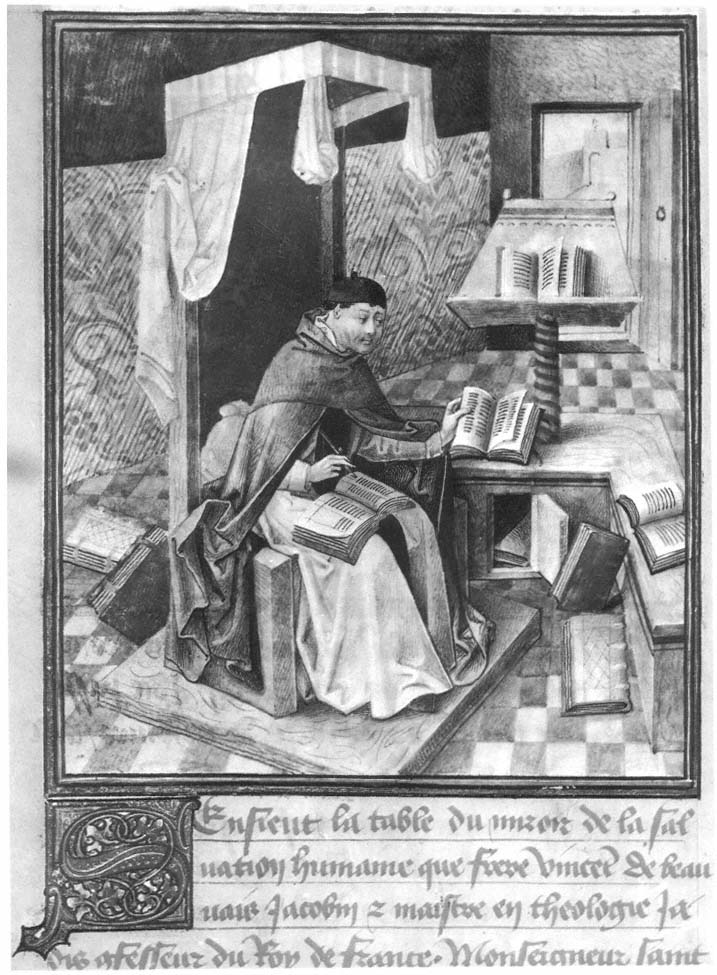Acknowledgments
There is an old Dutch saying: "Oude vriendschap slijt niet" (Old friendship does not wear out), which has been demonstrated throughout our work on this book. Whatever language our friends spoke, Dutch, French, German, English (and some know all of them and Latin), they generously gave invaluable advice, clues and translations. The acknowledgment of our debts to them gives us the opportunity of retracing with great pleasure our research voyages in 1978 and 1979.
In Belgium, the book designer Fernand Baudin led us to countless sources in the literature on the Speculum humanæ salvationis and on the Brethren of the Common Life, and even to the sites of their communities in the Forêt de Soigne, near Brussels. He facilitated our studies in the Bibliothèque Royale, willingly searched out answers to our questions, and sent documents to us after we had returned to San Francisco. We extend to him our profound thanks. Also most helpful at the Bibliothèque were the distinguished scholars Elly Cockx-Indestege and Claudine Lemaire. In Louvain, at the Katholieke Universiteit, Bert Cardon shared with us his work on the Flemish verse translation of the Speculum and the French copies at Saint-Omer.
Among our friends in Holland, we are deeply grateful to the late Dr. G. Willem Ovink of the University of Amsterdam, who shared his knowledge of Dutch printing, history, and art with us; and to his son, Arnold, who translated a pertinent text. Dr. Ovink's critical reading of our work was immeasurably helpful and supportive. Another friend, Sem Hartz, former art director and type designer of Joh. Enschedé en Zonen, in Haarlem, joined us in our study of the City Library's copies of the Speculum blockbooks, in the elegant security of the Frans Hals Museum where they are housed. The Director of the City Library, Cees van Dijk, provided us with important unpublished material. We are indebted to Dr. Pieter F. J. Obbema of the Library of the University of Leiden, for reading the typescript and for his suggestions.
The extensive research and publications of Wytze and Lotte Hellinga have been extremely valuable in our study of prototypography related to the blockbooks. We are grateful also to
Lotte Hellinga, now of the British Library, for reading our text and for her perceptive comments. At the British Library also, Nicolas Barker, Head of Conservation, has been generous with advice. David McKittrick at the Cambridge University Library kindly assisted us in the examination of its examples of early Dutch printing.
In Germany, Hermann Zapf's enthusiasm and knowledge were helpful, as always. He photographed for us two extraordinary Speculum manuscripts at Darmstadt and, by happy chance, brought the slides to us in California. Dr. Peter Zahn, then of the University Library of Munich, examined with us its copy, the only dated example of a Speculum blockbook. Across the Leopoldstrasse at the Bayerische Staatsbibliothek, we explored a number of the many Speculum manuscripts in that rich collection. At the fabled Herzog-August-Bibliothek at Wolfenbüttel, the staff kindly brought us the relevant treasures, and in Nuremberg we were graciously assisted by Frau Elisabeth Becker of the Stadtbibliothek and helped by the staff of the Germanisches Nationalmuseum. At the Gutenberg Museum in Mainz, the Director, Dr. Hans Halbey, showed us the Speculum manuscript and related materials there. Later, in San Francisco, he and Mrs. Halbey helped us with translations.
During our research in France, Mme. Jeanne Veyrin-Forrer of the Réserve des Incunabules at the Bibliothèque Nationale in Paris received us most warmly and assisted us with the study of its copies of the blockbooks. We are also much indebted to Adele Lancaster of Paris, for research and obtaining photographs for us there.
At the Houghton Library at Harvard, with the kind help of Eleanor Garvey, we arranged for the reproductions from its early Speculum manuscript. Marjorie Wynne, at the Beinecke Rare Book and Manuscript Library at Yale, made it possible for us to compare its "girdle book" Speculum manuscript with several incunabula editions. At Wesleyan University we were generously supplied with photocopies of the rare facsimile of the blockbook through Ellen d'Oench of the Davison Art Center.
Thanks to the help of James Wells and Anthony Amodeo of the Newberry Library in Chicago, we were able to study at greater length, in our own workshop, the color slides of the Library's magnificent French translation, with unexpected results.
In California, Carey Bliss of the Huntington Library in San Marino made available to us the only copy of a Speculum blockbook in the Far West, that of the second Dutch edition, and there we were able to examine five of the incunabula printings. We are also indebted to the assistance of James D. Hart, Director, and the staff of the Bancroft Library of the University of California at Berkeley; to D. Stephen Corey of the Gleeson Library of the University of San Francisco; and to the staff of the Stanford University Libraries.
We wish to acknowledge, with gratitude, the cooperation and help of Bernard Rosenthal, scholar/bookseller of San Francisco; Professor Fredric J. Mosher of the School of Librarianship and Information Sciences at the University of California at Berkeley, who gave many valuable suggestions; Anne H. van Buren of the Department of Fine Arts of Tufts University for her information on miniatures; and Professor James H. Marrow of the Art History Department of the University of California at Berkeley, for his patient, analytical, and helpful examination of our text and illustrations, and for his enthusiasm.
I-1.
Jean Miélot in his study.
Le Miroir de la salvation humaine .
Bibliothèque Nationale, Paris, Ms. fr. 6275, fol. 96 verso.
A. W. AND J. L. W.
